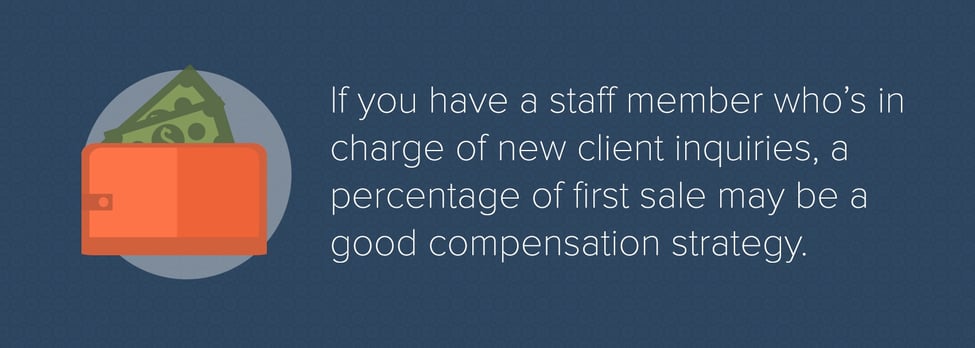
Incentivizing staff can be a powerful motivator to improve performance. However, in order to be effective, be sure you choose incentives that align with the specific performance outcome you desire. Watch out for unintended effects. Sometimes we try to incentivize one behavior, but get another one. Not to mention, be aware of how these incentives work with your business financials.
You may think: ‘share a percentage of profit’! This could be a good incentive—for the right individual with the right set of responsibilities. Yet, it’s probably a bad idea to incentivize everyone. For example, staff members who are not directly tied to profitability. Without the ability to directly affect profits, they won’t change their behavior the way you want because they’re still being rewarded whether or not they perform better.
However, an operations manager’s daily tasks CAN affect the bottom line. They’re intimately involved with both managing expenses and overall success of your business so it might make sense to pay them appropriately.

Want to learn how to get the most out of your employees?
Back to staff—how do you decide the best way to incentivize your staff? First, you have to answer:
What SPECIFIC outcome do you want?
When considering ways to incentivize staff, be very clear about the outcome you want. What specific duties do you want your staff to perform better? What business goal are you hoping the incentive will help you realize (i.e. better conversion rate, hitting a membership target, etc)? This helps determine how you structure incentive based pay.
Start by making a list of staff member responsibilities. Put a star by the areas you want better performance. Next, look at what revenue categories govern those specific responsibilities to determine if incentive-based pay makes financial sense. Again, the key to determining incentive-based compensation is to tie it to the specific performance you are trying to elicit.
7 ways you can best incentivize your staff:
- Desired outcome: Increase conversion of leads to sales.
Incentive: Commission based bonuses
If you have a staff member who’s in charge of new client inquiries, new client consults, or converting phone calls and emails into sales, a percentage of first sale may be a good compensation strategy. You can track the effectiveness of the staff member by tracking how many leads (phone, email, walk-in) are converted into sales.
- Desired outcome: Hit membership target
Incentive: Target-based bonuses
These can be specific to the employee’s role or can be global across your coaching staff. For example, let’s say you have a target of reaching 150 group clients and you have a staff of 5 instructors, each of whom contribute equally to member retention (for example, these staff members are responsible for following up with missing clients, etc). You can globally set that target and an associated bonus for each staff member if your team is able to reach it. Alternatively if you have a single staff member or manager who does the bulk of work with regards to member retention you can set an individual target.
- Desired outcome: Increase conversion rate from single visit to membership
Incentive: Conversion bonuses
This is a great one if you have staff members that are intimately involved with helping your clients move through the path of your business. For example, if you have a beginner workshop that’s the primary point of entry for new clients, you can reward the coaches of these critical classes in a couple of ways:
- A percentage of each converted client’s 1st month membership dues
- Be warned: this has the possibility of rewarding mediocrity (If only 30% convert they are still making extra cash). Avoid this by implementing stretch goals. Establish their targets for the term (i.e., 10 new accounts for the quarter). Give them a small bonus for hitting their numbers. Then, for every incremental sale, award them a percentage of each converted client’s 1st month membership dues. This incentivizes them to continue converting clients.
- A flat-rate bonus if they achieve or exceed a given conversion rate for each workshop (this may be more of a carrot, for if they don’t meet the target conversion rate, there is no bonus.)
- Desired outcome: Grow a stagnant program
Incentive: % of growth of specific program
Let’s say you have a fitness business that offers three programs: yoga, CrossFit, and boxing. If you have a staff member who is spearheading a fledgling program and is responsible for attracting and retaining members in that specific program, you could tie him or her to a percentage of growth for that program only. For example, let’s say your boxing program is currently bringing in $3000 in revenue per month, but growth is stagnant. You could create a new position called “Director of Boxing” with specific duties related to growing the program and pay him/her 10-15% of growth of that program. If s/he grows the program to $10,000 per month, s/he is earning an additional $700-$1050 per month.
- Desired outcome: Make sure staff is consistently sign clients into classes
Incentive: Attendance based bonuses
If you need to make sure your staff is consistently signing clients into classes (part of their job description and necessary for accurate business data), a per-person attendance bonus may be appropriate. In this example a nominal per-person plus a flat class rate is likely best.
Example: let’s say you pay your staff $20/class with a per head bonus of $0.25. A 20-person class represents an additional $5 in pay for that hour.
If you choose not to do a flat rate + per-person bonus and instead offer a larger per-person rate as staff pay, it’s important to be careful. Anytime you pay per-person you limit your ability to scale since you’re increasing variable costs with each new client. Run the numbers to ensure you’re not cutting too deep into your profit margin. Be particularly careful if you have several comped, trade, or other zero revenue clients, because when they attend a class it actually COSTS you money!
Example: a family member with a free unlimited membership may come to 15-20 classes in a month. Depending on what you’re paying per head (let’s say $4) this is a significant monthly cost ($60-$80). Now imagine your costs if you have 10-20 non-paying clients.
- Desired outcome: host profitable events
Incentive: Percentage of event-based profits
If you have a staff member responsible for organizing events or running paid challenges you can tie him or her to the profitability of those specific events. In this case, tying the staff member to profit not only incentivizes him or her to make it a great success, but also to keep expenses under control.
- Desired outcome: grow a profitable online store
Incentive: Percentage of retail profits
If you have a staff member who’s in charge of retail, he or she can be tied to specific revenue category. You’ll need to look at your margins across your products, but offering a percentage of profit can be a good strategy here. This person will be motivated to bring in items that will be hot sellers, as well as, manage all aspects of retail in your business including keeping cost of goods sold in check. You can give them inventory limits (i.e. no more than $3000 of inventory on hand). This encourages smart product choices since they won’t want to be sitting on $3000 of inventory unable to bring in any new product.
You can also reward them based on metrics such as inventory turnover, or the number of times a company’s inventory is sold and replenished in a given amount of time. A high number means that the company cycles through its inventory quickly, while a low number means that it’s sold through very slowly. It might take a little time to figure out what your average inventory is so you can create a realistic Inventory T/O goal with your retail manager.
COGS / Average Inventory = Inventory Turnover
Some other considerations:
- Not all staff will be incentivized the same way and some will simply be hourly employees
- Incentives should be based on the desired outcome and often based on the individual’s specific role at your business
- Be specific about responsibilities. “Growing a program” is nebulous—create or align specific duties or goals that help structure growth. Sit down with your employee and create a plan of action together.
- Unfortunately, some people will do a mediocre job regardless of incentives.
Recruit, leverage, and maintain your best team possible! Download Free Staffing 101 Guide.